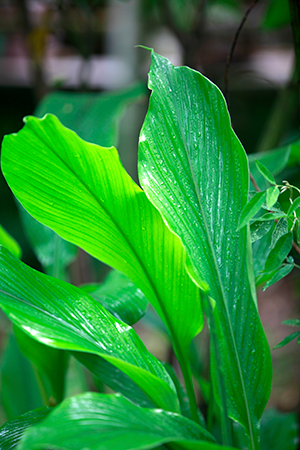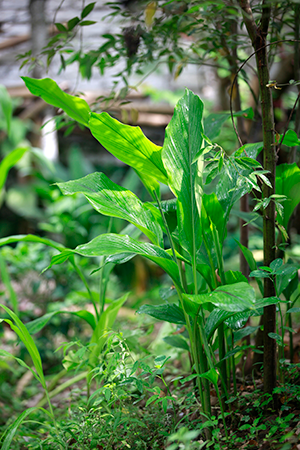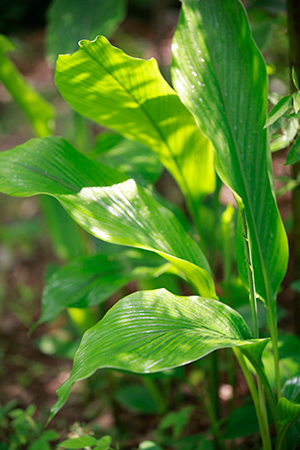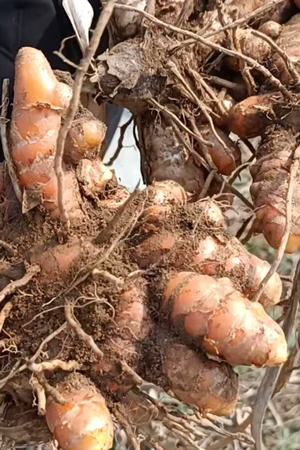The Traditional Way of Farming
Cultivating the Golden Spice: The Art and Science of Turmeric Farming
Step into the vibrant world of turmeric cultivation, where ancient traditions meet modern expertise to yield the golden treasure of our lands. Discover the secrets of cultivating and nurturing turmeric from seed to harvest as we unveil the intricate balance between nature’s forces and human care. At Haulage Naturals, we take pride in bringing you the very best of this exotic spice and we are excited to share the captivating story of its cultivation with you.
Climate & Soil
Turmeric thrives in diverse tropical climates, flourishing in hot, moist conditions. It is perfect for irrigated areas and adapts to various soil types, with a preference for well-drained sandy loam to loamy soil with moderate organic matter. However, it's crucial to avoid water logging and alkaline conditions as turmeric cannot withstand both. Turmeric is a resilient crop tolerant of shape.
Loam Soil is the mixture of clay, sand and silt soil. In comparison to other types of soil it is very fertile. It is best suited for cultivation, as the plant roots get sufficient amount of water and nutrients for their growth and development. Loam soil is often called ‘the gardener’s best friend’ and this region is blessed with it.
Loam Soil is the mixture of clay, sand and silt soil. In comparison to other types of soil it is very fertile. It is best suited for cultivation, as the plant roots get sufficient amount of water and nutrients for their growth and development. Loam soil is often called ‘the gardener’s best friend’ and this region is blessed with it.

Land Preparation: The Key To Cultivating Quality Turmeric
The cultivation of the finest turmeric begins with a precise process. To create the ideal seedbed, it is necessary to perform 2-3 ploughings and carefully plank the soil to craft the perfect seedbed. The key to vibrant turmeric growth is to create a pristine field that is free from stubble and weeds.
The Art of Seed Rate Management
Turmeric thrives from rhizome propagation. To begin this process, one should select fresh, robust and uniformly sized rhizomes, weighing approximately 6-8 quintals. These rhizomes are ideal planting material for an acre of land.
Farming communities of the Lakadong & Muleih region have been preserving and multiplying Lakadong mother plants for many generations.
Farming communities of the Lakadong & Muleih region have been preserving and multiplying Lakadong mother plants for many generations.
Optimal Timing for Cultivating Turmeric: The Key to Successful Turmeric Growth
To achieve a bountiful yield, turmeric should be planted directly in the field by the end of April. In northern districts, you can delay the sowing by up to a week. Alternatively, you may opt for transplanting until the first fortnight of June without compromising the yield.
To execute this method successfully, start by sprouting the rhizomes in a nursery, planting them close together. Then, transplant the 35-45 day-old seedlings into the field. This process ensures the cultivation of a thriving turmeric crop.
To execute this method successfully, start by sprouting the rhizomes in a nursery, planting them close together. Then, transplant the 35-45 day-old seedlings into the field. This process ensures the cultivation of a thriving turmeric crop.
Maximising Turmeric Yields with Manure
Turmeric thrives on organic nourishment, responding positively to this natural care. To achieve a bountiful turmeric crop with maximum yield, farmers employ the best natural resources, such as organic fertilizers like well-rotted cow dung and farm-grown compost, while steering clear of harmful chemicals and pesticides, thereby opting for a more eco-friendly approach.
Irrigation: The Key Component In Nurturing Turmeric Growth
In medium-heavy soil with a balance of rain, one can typically irrigate 15 to 25 times. Meanwhile, the light and airy red soil demands a more frequent rhythm, requiring 35 to 40 irrigation sessions to create the perfect conditions for our turmeric to thrive.
The Harvesting Period
Turmeric harvest typically spans from January to February. Different varieties of turmeric have varying maturation time spans. The easy-maturing types take 7-8 months, while medium varieties need 8-9 months. Harvesting begins when the leaves turn yellow and start to dry up. At maturity, leaves are cut close to the ground, the land is ploughed and rhizomes are carefully gathered by hand or with a crowbar/pitchfork. After picking, the rhizomes are cleaned and separated, ready for curing.
The yield of pure turmeric crop can range from 4,000 to 6,000 kg per acre and under exceptionally favourable conditions with good manuring and irrigation; it can reach as high as 8,000 kg per acre. The yield depends on several factors such as soil fertility, climate, and farming practices.
‘Dried Turmeric Chips’ are obtained when freshly sliced turmeric are naturally dried under the sunlight or by using dryers, resulting in 20% to 25% of its original weight, depending on its level of moisture content.
The yield of pure turmeric crop can range from 4,000 to 6,000 kg per acre and under exceptionally favourable conditions with good manuring and irrigation; it can reach as high as 8,000 kg per acre. The yield depends on several factors such as soil fertility, climate, and farming practices.
‘Dried Turmeric Chips’ are obtained when freshly sliced turmeric are naturally dried under the sunlight or by using dryers, resulting in 20% to 25% of its original weight, depending on its level of moisture content.
Previous slide
Next slide










